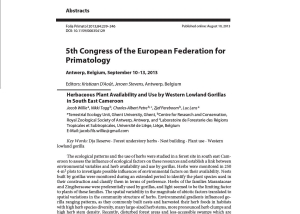Willie J., Tagg N., Petre C.A., Pereboom Z., Lens L.
The ecological patterns and the use of herbs were studied in a forest site in south east Cameroon to assess the influence of ecological factors on these resources and establish a link between environmental variables and herb availability and use by gorillas. Herbs were monitored in 250 4-m 2 plots to investigate possible influences of environmental factors on their availability. Nests built by gorillas were monitored during an extended period to identify the plant species used in their construction and classify them in terms of preference. Herbs of the families Marantaceae and Zingiberaceae were preferentially used by gorillas, and light seemed to be the limiting factor to plants of these families. The spatial variability in the magnitude of abiotic factors translated to spatial variations in the community structure of herbs. Environmental gradients influenced gorilla ranging patterns, as they commonly built nests and harvested their herb foods in habitats with high herb species diversity, many large-sized herb stems, more pronounced herb clumps and high herb stem density. Recently, disturbed forest areas and less-accessible swamps which are characterised by a limited visibility and a high density of herbs can play a crucial role in the ecology and conservation of gorillas as they provide abundant and clumped nest-building materials, year-round nutrient-rich herbs and natural protection from hunters. Although light appears to be an important factor for herb availability, soil properties and climatic variables potentially represent important drivers. Conservation-applied research efforts should therefore focus on issues such as the effect of climate change on gorilla plant resources and the impact of logging-induced alterations of canopy and forest soil properties on herbs.
Consultez la notice complète de l’article sur ORBi

